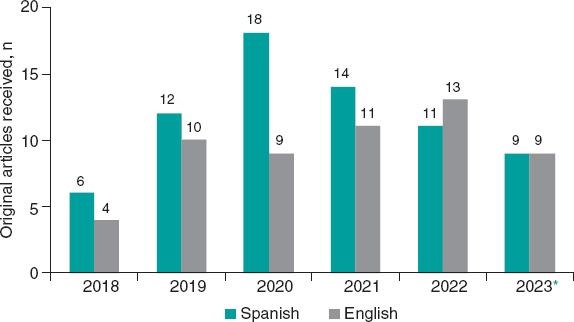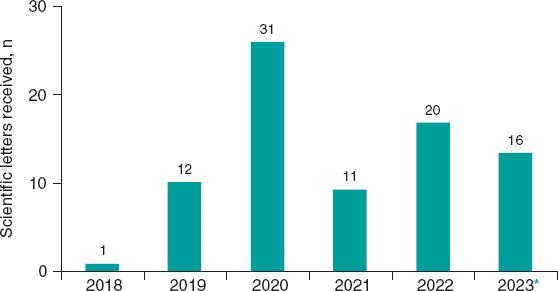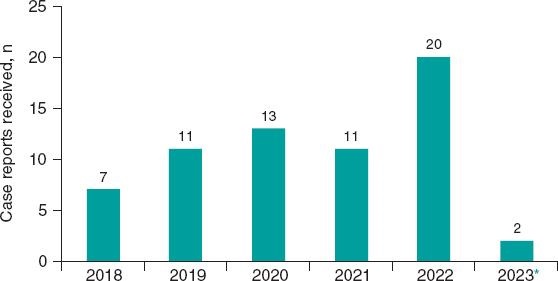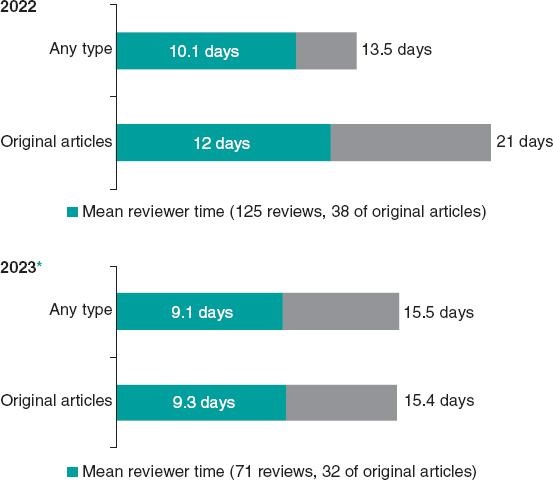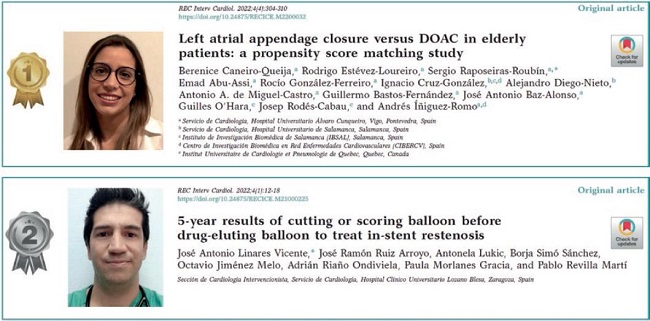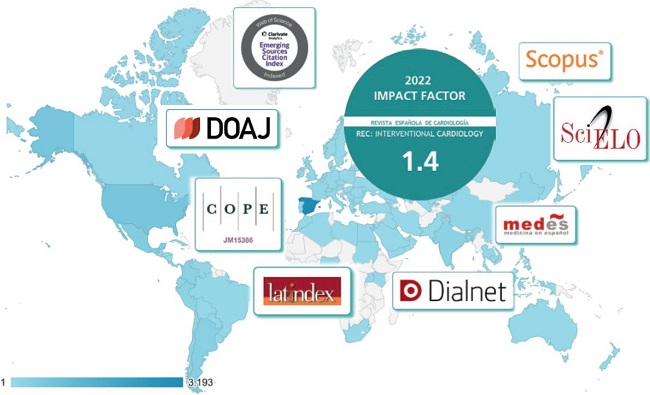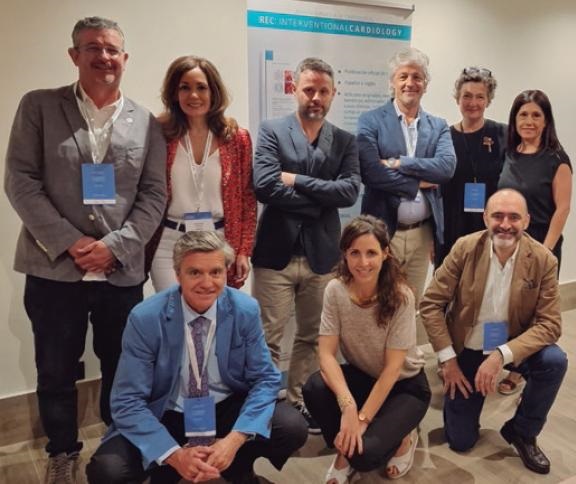My SciELO
Services on Demand
Journal
Article
Indicators
-
 Cited by SciELO
Cited by SciELO -
 Access statistics
Access statistics
Related links
-
 Cited by Google
Cited by Google -
 Similars in
SciELO
Similars in
SciELO -
 Similars in Google
Similars in Google
Share
REC: Interventional Cardiology
On-line version ISSN 2604-7276Print version ISSN 2604-7306
REC Interv Cardiol ES vol.5 n.4 Madrid Oct./Dec. 2023 Epub Mar 04, 2024
https://dx.doi.org/10.24875/recic.m23000408
Editor's page
Marking a milestone. REC: Interventional Cardiology assigned its first impact factor
At the time of drafting this Editor's page, we were thrilled to learn that REC: Interventional Cardiology has received its very first impact factor (IF) of 1.4 in the latest edition of the Journal Citation Reports.1 This is outstanding news and the assigned IF greatly exceeds our expectations.
Like many other editors before us, we have previously mentioned on past Editor's pages the excessive and almost obsessive reliance of the current medical publication world on IF.2-6 Everything seems to revolve around this highly coveted metric, which is made public by all medical journals without exception, especially when it increases.
The manuscripts published in the different sections of REC: Interventional Cardiology have significantly impacted the interventional cardiology community in Spain and abroad. Indeed, some of our articles have received numerous citations in top international journals. Likewise, consensus documents drafted by the Interventional Cardiology Association of the Spanish Society of Cardiology (ACI-SEC) have achieved significant dissemination and impact.
However, despite the obvious negative aspects of IF, the truth is that it has become the most widely recognized and accepted metric to estimate the value, visibility, and impact of scientific publications. Therefore, if there is anything we would like to highlight in this Editor's page, it is precisely the achievement of the journal's very first IF. This recognition serves to show that our more than 5 years of hard but very satisfying work and has finally paid off and adds to the multiple indexations already achieved to enhance the journal's dissemination and visibility.
The credit for achieving this milestone goes to the entire interventional cardiology community, the boards of directors of the ACI-SEC, authors, reviewers, and everyone on the editorial team and in the journal's editorial office.
As we have worked to position our journal more prominently in terms of visibility, we have made changes to how its contents are structured over the past year, as will be discussed below.
EDITORIAL ACTIVITY
The key issue for a scientific publication is to receive a sufficient number of manuscripts across multiple categories to allow selection of content of the highest possible quality.
Our quarterly issues include original and review articles, scientific letters, case reports, images, debates, and editorial comments on topics of special interest. Periodically, we also feature consensus documents and the abstracts of communications presented at the ACI-SEC congress.
Figure 1 illustrates how the number of research articles published increased within the first 3 years and has remained steady ever since. Figure 2 shows the number of unsolicited manuscripts received.

Figure 1. Total contents published, years 2019-2022. Abstracts from congresses are counted as 1 unit. Each case report is counted as 3 units, because it consists of 3 independent articles: Presentation, How would I approach it? and Resolution.
Original articles
Figure 3 illustrates a notable surge in the submission of original articles in the past year. Given our newly-assigned IF, we anticipate that this upward trend will persist, allowing us to continue to select the best possible manuscripts for publication.
It is striking that the number of articles received in English has been growing steadily (figure 4). In fact, a significant number of the submitted manuscripts (including all types of articles) come from other countries, notably Portugal, Mexico, the United States, Italy, and Argentina.
An essential factor for a scientific journal is how quickly editorial decisions are reached. In this regard, we are highly satisfied with our journal's turnaround times (figure 5), which compare favorably with those of other high-prestige publications.
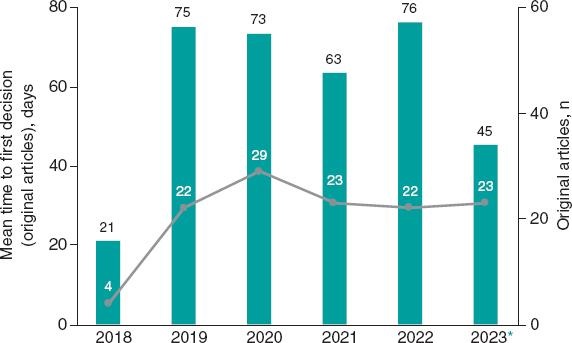
Figure 5. Average days to make the final decision (data above each column) and number of original articles reviewed (in white inside each column).
As emphasized in recent years, our main objective is to consolidate REC: Interventional Cardiology as a leading publication in our field. Because our goal is to increase the number of original articles received, we extend an invitation to members of the interventional cardiology community to submit their research articles to our journal.
Scientific letters
This type of article is gaining popularity and is being received more frequently. Figure 6 illustrates the notably high peak in manuscript submissions during the first wave of the COVID-19 pandemic. Because of this increase, the number of letters published per issue varies, depending on demand.
Sometimes, at the suggestion of reviewers and the editorial team, authors have adapted manuscripts initially submitted as original articles into scientific letters. The editorial process of these manuscripts is usually efficient, particularly if they incorporate the scientific recommendations provided by the editorial team in the original version.
Case reports
The number of case reports received increased substantially in 2022 (figure 7). However, only 1 case report is published per issue although each case report consists of 3 parts: Presentation, How would I approach it? and Resolution, resulting in just 4 cases being published in a single year. Because of the backlog of case reports in the publishing queue, we have to be highly selective in our choices, and our acceptance rate for manuscripts submitted to this section is very low, at < 35%.
Images in cardiology
The field of interventional cardiology creates a huge amount of excellent visuals, making images a limitless source of manuscripts. Although all are interesting, only a few can be published due to space constraints. In the past year, submission of these image-based manuscripts has increased (figure 8), leading to a higher rejection rate, which in 2022 stood at 64%.
Contents transferred from Revista Española de Cardiología
One of the sources of manuscripts for journals within the same editorial family is the transfer of manuscripts from main journal to the sister publications. Revista Española de Cardiología attracts an extremely large number of submissions, far exceeding its capacity for acceptance, resulting in a notably high rejection rate, even for articles of undeniable interest. Obviously, there is a risk that the option to transfer manuscripts from a higher- to a lower-impact journal will not be taken up by authors.
Although the offer to transfer remained stable for several years, it has increased during the first half of 2023, coinciding with authors' decisions to transfer their manuscripts to REC: Interventional Cardiology (figure 9). This is excellent news, and we are confident that our recently acquired IF will further enhance the appeal of this option to authors.
LATEST EDITORIAL CHANGES
At REC Publications, we are committed to an ongoing process of evaluation and improvement. Changes are often made to enhance the quality of our journal, streamline the editorial process, and improve the overall experience for our authors. While some of these changes are internal and may not be noticeable to our readers, others may be more visible to our regular visitors.
One of the most significant changes made last year was the elimination of the Clinical cases section. Although appealing to many authors, this section has been phased out of most high-ranking journals. In addition, the section created a significant backlog of manuscripts, leading to publication delays of more than 1 year, and an extremely high rejection rate. Nonetheless, clinical cases featuring highly illustrative images may still be submitted, although these should be submitted as “Images in cardiology”.
As for the Scientific letters section, only articles containing original data and describing the authors' experience are now considered for this section. Since June 2023, letters describing clinical cases are no longer accepted for evaluation under this section. We no longer accept letters describing case reports for evaluation.
REVIEWERS
Reviewers are key to ensuring the quality of scientific publications through the best method devised for this purpose to date: the peer review process. This commendable work is carried out voluntarily, with reviewers dedicating their valuable time to review and try to improve the quality of the manuscripts assigned to them.
Testament to our reviewers' outstanding work are the excellent review times, which have remained optimal throughout our journal's existence (figure 10).
Table 1 shows the names of all reviewers who reviewed manuscripts for REC: Interventional Cardiology from July 1, 2022 through June 30, 2023. Table 2 shows those considered elite reviewers in 2022 due to the volume, speed, and quality of their work.
Once again, we wish to express our gratitude to all those who have made this achievement possible.
Table 1. Reviewers of REC Interventional Cardiology who conducted evaluations from July 1, 2022 through June 30, 2023.
| César Abelleira | Felipe Hernández |
|
| |
| Juan H. Alonso-Briales | Borja Ibáñez |
|
| |
| María Álvarez-Fuente | Andrés Íñiguez |
|
| |
| Ignacio Amat | Santiago Jiménez-Valero |
|
| |
| Dabit Arzamendi | María López-Benito |
|
| |
| Pablo Avanzas | José R. López-Mínguez |
|
| |
| Fernando Ballesteros | Ramón López-Palop |
|
| |
| Teresa Bastante | Fernando Lozano |
|
| |
| José A. Baz | Íñigo Lozano |
|
| |
| Pedro Betrián | Gerard Martí |
|
| |
| Salvatore Brugaletta | Javier Martín-Moreiras |
|
| |
| Ramón Calviño | Guillem Muntané |
|
| |
| Santiago Camacho | Luis Nombela |
|
| |
| Xavier Carrillo | Imanol Otaegui |
|
| |
| Fernando Cebada | Manuel Pan |
|
| |
| Ángel Cequier | Isaac Pascual |
|
| |
| Belén Cid | Eduardo Pinar |
|
| |
| Juan G. Córdoba | Javier Portales |
|
| |
| Félix Coserria | Sergio Raposeiras-Roubín |
|
| |
| Ignacio Cruz | Fernando Rebollal |
|
| |
| Javier Cuesta | Fernando Rivero |
|
| |
| María Del Trigo | Oriol Rodríguez |
|
| |
| David Del Val | Sergio Rodríguez de Leiras |
|
| |
| José F. Díaz | Alejandro Rodríguez-Ogando |
|
| |
| Alejandro Diego-Nieto | Fernando Rueda |
|
| |
| Felipe Díez-Delhoyo | Rafael Ruiz de Araujo |
|
| |
| Jaime Elízaga | Juan M. Ruiz-Nodar |
|
| |
| Ignacio Ferreira | Rafael Ruiz-Salmerón |
|
| |
| José L. Ferreiro | José Rumoroso |
|
| |
| Xavier Freixa | Manel Sabaté |
|
| |
| Guillermo Galeote | Pablo Salinas |
|
| |
| Sergio García-Blas | Ángel Sánchez-Recalde |
|
| |
| Tamara García-Camarero | Juan Sanchis |
|
| |
| Bruno García del Blanco | Ricardo Sanz-Ruiz |
|
| |
| Arturo García-Touchard | Fernando Sarnago |
|
| |
| Javier Goicolea | Ana Serrador |
|
| |
| Joan A. Gómez-Hospital | Javier Suárez de Lezo |
|
| |
| Josep Gómez-Lara | Luis Teruel |
|
| |
| Antonio E. Gómez-Menchero | Ramiro Trillo |
|
| |
| Nieves Gonzalo | Leire Unzué |
|
| |
| Enrique Gutiérrez-Ibañes | Beatriz Vaquerizo |
|
| |
| Federico Gutiérrez-Larraya | |
Table 2. Elite reviewers in 2022*
| Teresa Bastante |
|
|
| Salvatore Brugaletta |
|
|
| Felipe Hernández |
|
|
| Manuel Pan |
|
|
| Pablo Salinas |
*Based on the reviews conducted from September 1, 2021 through August 31, 2022.
DISSEMINATION
The 34th ACI-SEC Congress was held in Santander from June 7 to 9, 2023. The abstracts were published in our journal by the end of May, and REC: Interventional Cardiology was present as usual, at the stands of the meeting.7 At this congress, the prizes for best articles published in REC: Interventional Cardiology were awarded: €1500 for the winner and €1000 for the runner-up.8,9 (figure 11).
Traffic to our website has increased by more than 14% in terms of page views and by 9.4% in terms of users over the past year (from June 2022 through June 2023) compared with the previous period.10
Most of our web traffic comes from search engines, 46% from direct searches for the journal, and 31% from keyword searches. Access to the journal from social media has doubled over the past year from 6% to 12%. Our readers come predominantly from Spain, followed by the United States and Mexico, and 60% of them access our contents from their computers, although the journal has been increasingly accessed from mobile devices in the last few months. The social network most widely used by cardiologists to read our articles is Twitter, where we have 21 000 followers.11
We wish to express our gratitude to REC Publications IT consultant, Juan Quiles, for his excellent work and the changes he has implemented to highlight the authors and revitalize the content through the creation of threads and more multimedia content.
In terms of the most viewed manuscripts, review articles have garnered particular attention over the past year. For instance “Vascular access approach for structural heart procedures” received 3000 views, and “Calcified coronary artery disease: pathophysiology, intracoronary imaging assessment, and plaque modification techniques,” received 4258 views. Special articles, such as “Plaque modification techniques to treat calcified coronary lesions. Position paper from the ACI-SEC” marked the introduction of the new Editor's videos format15 in the first issue published in 2023.
Finally, we have replaced the interviews we used to conduct with a brief 2-minute presentation delivered by one of the authors. This change was made to enhance accessibility on social media and mobile devices. Contents have been added to SEC CardioTV structure, resulting in increased visibility. Our audience appears to appreciate this change, with the first videos exceeding 7000 views on multiple platforms compared with the average 800 views with the previous format.
We are on the right path and would like to thank you all for helping to make it possible.
IMPACT FACTOR
As mentioned earlier, the latest edition of Journal Citation Reports, published on June 28, 2023, revealed the new IF data for academic journals.1 The most significant development for REC Publications is the award of the very first IF for REC: Interventional Cardiology, as a journal indexed in the Web of Science Core Collection Emerging Sources Citation Index. The journal has made its debut in this index with a commendable IF of 1.4. Meanwhile, Revista Española de Cardiología has retained its position in the first quartile of cardiovascular-themed journals with an IF of 5.9.
This IF of 1.4 not only reflects the quality of the research published but also the impact and dissemination of the journal's content, which is published at no cost to authors and is available in Spanish and English through an open-access model. As the official publication of the ACI-SEC, the journal also publishes consensus documents on current topics12,14,16,17 (figure 12), whose influence has extended beyond our borders. This was the case of the fast-track publication of documents on COVID-19, which had a tremendous impact on interventional activity in the early stages of the pandemic, as well as other manuscripts whose content has resonated in international conferences. The recently awarded IF adds to all these achievements, which include other indexations already obtained during the 5-year history of our journal: Scopus, Latindex, DOAJ, Dialnet, and Medes. At the time of writing this editorial, we have received news that REC: Interventional Cardiology has just been accepted into another prestigious repository: Scielo. All of these achievements contribute to increasing the bibliometric value of all the articles published in our journal (figure 13).
We have now set our sights on Medline, and we are currently undergoing a thorough review of our contents and formats in the hope of obtaining a favorable evaluation.
In the coming years, the bibliometric growth of REC: Interventional Cardiology will depend largely on the continued support of the scientific community. Therefore, our team encourages authors to submit their research work. For our part, we are committed to maintaining our swift decision-making times and quality throughout the entire editorial process.
ACKNOWLEDGMENTS
As the editor-in-chief, I wish, once again to express my heartfelt gratitude to the associate editors: Fernando Alfonso, Raúl Moreno, Soledad Ojeda, Armando Pérez de Prado, and Rafael Romaguera (figure 14). The best dream team ever assembled.
REC: Interventional Cardiology is the official publication of ACI-SEC, and very few select journals have the endorsement of a professional association like ours, which truly sets us apart. The unwavering support of the ACI-SEC boards has been instrumental in bringing this project to fruition since its inception. The ACI-SEC fully funds the journal, ensuring its high production quality, and provides free access to readers, which would not be feasible without the selfless support from the interventional cardiology devices market.
As always, we wish to express our appreciation for the excellent work and dedication shown by the members of REC Publications editorial team, including Iria del Río, Eva M. Cardenal, Belén Juan, María González Nogal, Helena Gómez Lobo, and our latest addition, Javier Esquinas. We also extend our thanks to our IT consultant, Juan Quiles, SEC IT team, and the entire team at Permanyer Group.
What truly matters is not the goals we set in life but the path followed in the meantime. Setting goals is good, but moving step by step and seizing the moment is the true secret of success.
REFERENCES
1. Clarivate Analytics. Journal Citation Reports 2023 Edition. Disponible en: https://clarivate.com/training/journal-citation-reports-2023-edition/. Consultado 28 Jun 2023. [ Links ]
2. De la Torre-Hernández JM, Alfonso F, Moreno R, Ojeda S, Pérez de Prado A, Romaguera R. REC: Interventional Cardiology: on the right track. REC Interv Cardiol. 2022;4:261-266. [ Links ]
3. De la Torre-Hernández JM, Alfonso F, Sanchis J, Moreno R. REC: Interventional Cardiology in the COVID-19 year. REC Interv Cardiol. 2021;3:239-244. [ Links ]
4. De la Torre-Hernández JM, Alfonso F, Sanchis J, Moreno R. The first two years of REC: Interventional Cardiology. REC Interv Cardiol. 2020;2:233-238. [ Links ]
5. De la Torre-Hernández JM, Alfonso F, Sanchis J, Moreno R. REC: Interventional Cardiology:A new journal, but not just one more journal. REC Interv Cardiol. 2019;1:2-3. [ Links ]
6. Alfonso F, Bermejo J, Segovia J. Impactology, impactitis, impactotherapy. Rev Esp Cardiol. 2005;58:1239-1245. [ Links ]
7. Resúmenes presentados al 34 Congreso de la Asociación de Cardiología Intervencionista de la Sociedad Española de Cardiología. REC Interv Cardiol. 2023;C1-C7. [ Links ]
8. Caneiro-Queija B, Estévez-Loureiro R, Raposeiras-Roubín S, et al. Left atrial appendage closure versus DOAC in elderly patients: a propensity score matching study. REC Interv Cardiol. 2022;4:304-310. [ Links ]
9. Linares Vicente JA, Ruiz Arroyo JR, Lukic A, et al. 5-year results of cutting or scoring balloon before drug-eluting balloon to treat in-stent restenosis. REC Interv Cardiol. 2022;4:12-18. [ Links ]
10. REC Interventional Cardiology. Disponible en: https://recintervcardiol.org/. Consultado 30 Jun 2023. [ Links ]
11. Twitter. @RevEspCardiol. Disponible en: https://twitter.com/revespcardiol. Consultado 27 Jun 2023. [ Links ]
12. Freixa X, Romaguera R, Botas J, Trillo R, Martín-Moreiras J, Jurado-Román A. Vascular access approach for structural heart procedures. REC Interv Cardiol. 2022;4:311-318. [ Links ]
13. McInerney A, Escaned J, Gonzalo N. Calcified coronary artery disease: pathophysiology, intracoronary imaging assessment, and plaque modification techniques. REC Interv Cardiol. 2022;4:216-227. [ Links ]
14. Jurado-Román A, Gómez-Menchero A, Nieves Gonzalo N, et al. Plaque modification techniques to treat calcified coronary lesions. Position paper from the ACI-SEC. REC Interv Cardiol. 2023;5:46-61. [ Links ]
15. REC: Interventional Cardiology. Vídeos del Editor. Disponible en: https://recintervcardiol.org/es/videos-del-editor/. Consultado 30 Jun 2023. [ Links ]
16. Rodríguez-Leor O, Cid-Álvarez AB, Moreno R, et al.;on behalf of the investigators from the Infarction Code Working Group of the ACI-SEC. Regional differences in STEMI care in Spain. Data from the ACI-SEC Infarction Code Registry. REC Interv Cardiol. 2023;5:118-128. [ Links ]
17. Ballesteros Tejerizo F, Coserría Sánchez F, Freixa X, et al. Spanish cardiac catheterization in congenital heart diseases registry. Second official report from the ACI-SEC and the GTH-SECPCC (2021). REC Interv Cardiol. 2023;5:185-192. [ Links ]











 text in
text in 



